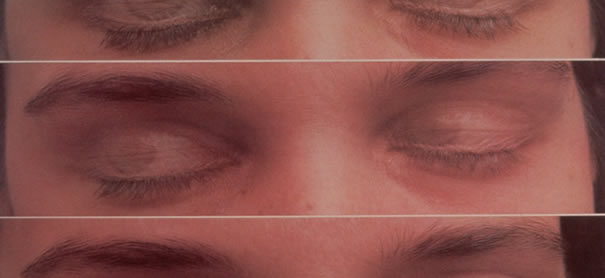
You already know that lucid dreaming only happens at certain stages of your sleep cycle and so you may be wondering at what point during your sleep you lucid dream.
Contents
How many hours sleep do you need to lucid dream?
When it comes to dreaming, and especially lucid dreaming, you need top enter the REM state.
Your sleeping body does not immediately enter this state when you fall asleep.
As a general rule you need at least 90 minutes of sleep to enter your first lucid dream.
The only exception is when you experience the REM Rebound effect where you can enter a lucid dream instantly upon falling asleep.

It is possible to use techniques and supplements to create a state of REM Deprivation that leads to the REM Rebound effect.
To understand how many hours sleep are normally required to lucid dream we need to quickly look at the normal sleep cycles we experience when we drift off into slumber.
This investigation will also highlight how sleep length can also affect affect both the number of lucid dreams you have and their duration.
The stages of sleep and how they affect the timing of our dreams
During a normal sleep session we will enter multiple sleep cycles.
Each sleep cycle consists of the same three stages of sleep.
Understanding these stages is necessary for understanding when we experience lucid dreams.
The 3 stages of every sleep cycle:
- Light sleep. In this stage we are in a hazy state of consciousness being not quite asleep but not quite awake either.
- Deep sleep. In this stage of sleep we are fully unconscious. This is the stage of sleep where the brain is washed clean with cerebrospinal fluid and the body is repaired at a cellular level.
- REM sleep. REM refers to rapid eye movement. Although we can have normal dreams at any point during sleep, REM is the stage where vivid dream occurs. Lucid dreaming occurs during the REM stage of sleep.
When we sleep over a prolonged period of time, for example when we sleep at night, we go through several sleep cycles. Each cycle will include the 3 stages of sleep mentioned above.
This means we move through the stages as follows:
Cycle 1: Light sleep > Deep sleep > REM sleep. Cycle 1 completes.
Cycle 2: As we move out of REM sleep in cycle 1, we move into a new cycle i.e. Light sleep > Deep sleep > REM sleep. Cycle 2 completes.
Cycle 3: As we move out of REM sleep in cycle 2, we move into another cycle i.e. Light sleep > Deep sleep > REM sleep. Cycle 3 completes.
As we sleep, we loop through the cycles in the above manner, experiencing each of the 3 stages in each cycle, until we wake up naturally.
In our last cycle we are meant to experience each of the 3 stages of sleep but this usually does not happen if we are woken prematurely.
For example by an alarm clock, loud noise or by someone else.
This phenomenon can actually be used to our advantage, to have lucid dreams sooner during sleep and to make them last longer.
I will revisit this topic later in the article.
As you can see from the simple equation above, after each REM stage we move back into a light stage of sleep where we are not technically fully asleep but are in that hazy state between wakefulness and unconsciousness.
Most of us wake up at the end of each cycle as we enter a light sleep stage again. We simply forget it happened because we fall asleep again so quickly. This happens several times during a prolonged sleep period.
Now, to see how these cycles affect the times of lucid dreams and the number of lucid dreams, in addition to their duration, we need to examine the nature of these cycles in closer detail.
You see the duration of the stages of sleep are not the same in each cycle.
The 3 sleep stages have different lengths depending on what cycle you are experiencing and this has a direct effect on the timing of dreams and lucid dreams, as we will soon see.
The stage of sleep where lucid dreaming occurs
Modern research into dreaming indicates that we can have a dream at any point while we sleep.
However, vivid dreams (the ones we usually remember) happen in REM sleep.
Lucid dreams occur during the REM stage of sleep.
Although we can have normal dreams at any stage of sleep, we can only lucid dream during the stage of rapid eye movement (REM).
Everyone experiences vivid dreams during REM stage of sleep, even those who do not remember their dreams.

The experience of vivid dreaming opens up the opportunity to deliberately induce a lucid dream.
Because vivid and very clear dreams only ever happen in the REM stage of sleep lucid dreams tend to be very clear and vivid because they only ever happen during REM.
So, we now know that REM sleep is required for lucid dreaming but when do we experience REM? (FYI: there are several techniques to induce lucid dreams deliberately during REM though some people can do it naturally).
The point in sleep when someone usually experiences lucid dreams
So, when do you lucid dream during sleep?
You only ever lucid dream in the REM stage of sleep.
As a general rule you will enter REM and have your first lucid dream 90 minutes after beginning your first sleep cycle (falling asleep).
With every completed sleep cycle you will enter the next REM stage quicker thus letting you have lucid dreams quicker.
As mentioned previously, the exception is when you experience REM Rebound and enter REM directly upon falling asleep where you can lucid dream.
This can be deliberately induced.
Because you dream several times each night (or over any prolonged sleep period – including during the day) this gives you the opportunity to lucid dream several times.
The time when these lucid dreams occur differ throughout a prolonged sleep period.
Let’s take a lot at how that works now.
How the sleep cycles affect the length of our lucid dreams
All our sleep cycles are not equal. Although they last roughly the same amount of time the length of the sleep stages in each cycle is different.
This has a direct effect on lucid dreaming.
Although different people sleep for different lengths of time for the sake of convenience and to avoid confusion, I will assume that 8 hours of sleep is the average for most people so I can explain how all of this works.
So, let’s look at how we go through the sleep cycles during an 8 hour sleep period to see how it affects lucid dreaming.
In the first 4 hours of sleep we spend more time in the deep stage of each sleep cycle.
As we progress through prolonged sleep we move away from longer deep sleep periods and into longer REM sleep periods.
In the second 4 hours of sleep we spend more time in the REM stage of each sleep cycle.
Because we enter REM quicker with each sleep cycle in the second half of our sleep period this means our dreams are closer together than they are in the first half of our sleep.
It also means they last longer.
Because we only lucid dream in REM this means lucid dreams can occur quicker in each sleep cycle, during the second half of our sleep period, i.e. after 4 hours of sleep.
These lucid dreams do not just happen quicker, they also last longer.
This is why some lucid dreamers will attempt to deliberately induce a lucid dream after they have been asleep for 4 hours by waking themselves and then performing the WBTB (wake back to bed) technique.
However, there is a way in which you can have a lucid dream immediately upon falling asleep without having to go through the first 2 stages of sleep.
There is one exception to the normal workings of our sleep cycles and the duration of our sleep stages.
This one exception directly affects the length of sleep time it takes us before we lucid dream.
When we experience something called REM Deprivation we can use its effect to enter a lucid dream directly upon falling asleep.
How To Lucid Dream In 5 Minutes Or Less Using The REM Rebound Effect
Although there is a lot of hype online and a ton of inaccurate and sensational claims, especially on YouTube, about being able to guarantee a lucid dream tonight or being able to lucid dream without effort, most of these claims are ridiculous.
You must be willing to put in the effort to learn how to lucid dream.
There is no magic bullet but trust me … it is well worth the effort!
However, there is one outrageous lucid dreaming claim made online that is actually true!
Surprisingly to some people, you really can lucid dream in 5 minutes or less! This capability relies on something known as the REM Rebound Effect.
As you seen earlier in this article, in the first 4 hours of sleep we spend more time in the deep stage of sleep.
This is necessary so that the brain is washed clean with cerebrospinal fluid and the body are repaired at a cellular level.
However, to get a truly restful and healthy amount of sleep, the mind and body requires an equal amount of deep sleep and REM sleep.
You would think that our brain would naturally just alternate between the two sleep stages to ensure that we get a balanced night sleep, but as we have seen that does not happen.
I won’t venture too deeply into the reasons for not having balanced cycles that simply alternate past giving my own opinion on what is happening.
Of course it is only conjecture on my part but I believe that spending the first part of a prolonged sleep period in deep, restorative sleep is a safety mechanism.
This sleep time is used by the brain to ensure the healthy and optimum levels of mind and body.
Remember in deep sleep the brain is washed with cerebrospinal fluid to remove accumulated metabolic wastage.
Also the cells of the body are replenished and renewed so making sure this happens even if you get very limited sleep seems pretty essential to me.
However, this is pure conjecture on my part and just my opinion.
I am neither a medical practitioner nor a neuroscientist. You can read more about it here.
Anyway, back to REM sleep.
When we fail to get enough sleep, for example we only get 4 – 5 hours, we will have imbalance between the amount of deep sleep we have experienced and the amount of REM sleep we have experienced.
Although we still don’t fully understand the role that dreams play in our health we do know the devastating effects of not dreaming.
Therefore we can see that REM sleep is just as important as deep sleep and if you don’t get enough of it your brain will take steps to rectify the imbalance.
When we don’t get enough REM sleep this is called REM Deprivation.
If we experienced REM Deprivation then the next time we sleep the brain will attempt to address the imbalance by skipping the earlier stages of sleep and going directly into REM sleep.
This is known as the REM Rebound Effect.
The brain will attempt to address the imbalance of REM Deprivation using the REM Rebound effect.
Because lucid dreams happen during REM this means it is possible to have a lucid dream immediately upon falling asleep due to REM Rebound.

So, by deliberately causing REM Deprivation it is possible to use REM Rebound to have a lucid dream immediately upon going to sleep.
You do this by waking yourself before your natural sleep period has concluded (though you can also cause it through the use of certain sleep herbs)
REM Rebound lets you lucid dream without having to wait 90 minutes for the first short lucid dream, or several hours for the longest one.
Additionally, REM Rebound does not just make lucid dreams happen immediately it also makes them last longer.
The REM imbalance caused by REM Deprivation means the brain will not just go into REM instantly upon sleep, but it will stay in REM longer simply so it can address that imbalance and restore equilibrium.
This is why many lucid dreamers will use naps to induce instant lucid dreams.
In most cases you don’t even need to wait 5 minutes!
Of course you need to know how to lucid dream. REM Rebound won’t cause lucid dreams it just makes it easier to have them quickly.
You still need to be trained to lucid dream.
If you would like to learn how to lucid dream effectively, i.e. learn to induce lucid dreams and learn how to control every aspect of them, then consider making the small investment it takes to use a really good lucid dreaming course that teaches you both.
